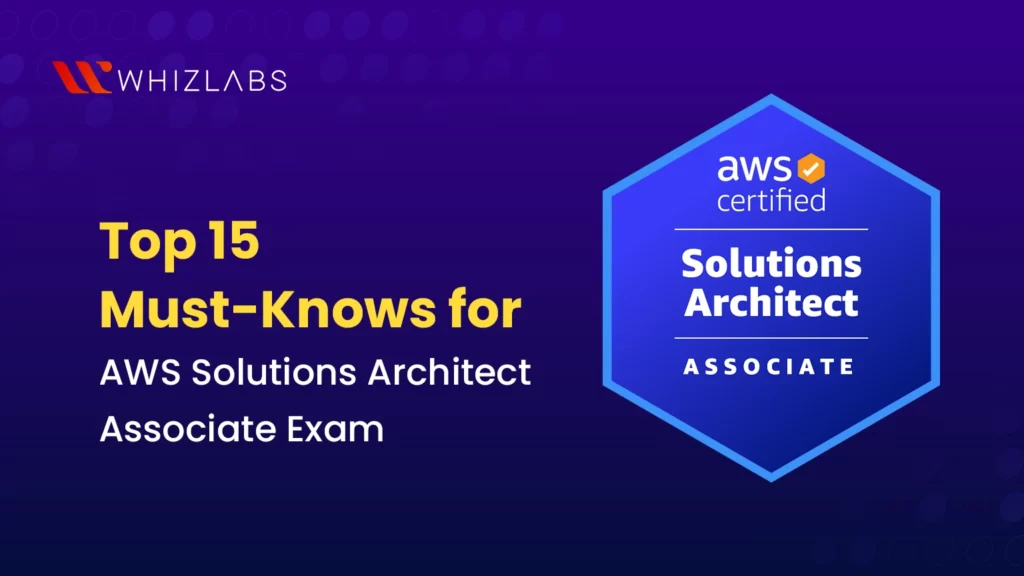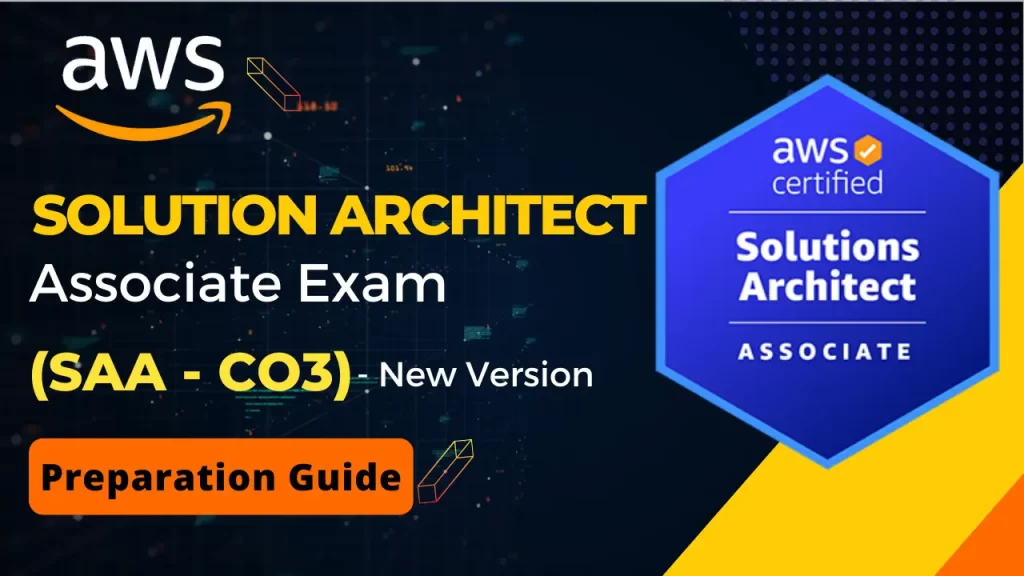If you are about to take the AWS Certified Solutions Architect Associate (SAA-C03) exam, you should ensure that your abilities to plan and implement scalable, resilient, secure, and cost-effective architecture on AWS have been met. Our learners are stimulated by it, and, given proper preparation, it is quite doable. Pick up this guide and find out more.
How the SAA-C03 Exam is Structured: Format, Duration, and Domains
The SAA-C03 focuses on people who have at least a year of practical experience designing distributed systems on AWS. It examines practical knowledge rather than theoretical, and it is important to know how to apply things as much as one knows the services to be remembered.
The exam consists of 65 questions, which can be a mix of multiple-choice and multiple-response, and you have 130 minutes to complete it. It’s divided into four main domains:
Core Topics Covered in the SAA-C03 Exam
Topic 1 – Design Secure Architectures: IAM, Security Groups, KMS, and Encryption
Security is a major theme in the exam. You’ll see multiple questions about Identity and Access Management policies, roles, and permission boundaries. Also, understand how Security Groups and Network ACLs work in practice.
The Key Management Service (KMS) is frequently mentioned and mainly refers to encryption at rest and in transit, cross-account access, and key rotation. Be aware of how to encrypt S3 objects and EBS volumes, and the way KMS can be used along with Amazon RDS and Lambda.
Common Questions on AWS Security in SAA-C03
“A company needs to share encrypted data with another AWS account securely. Which services/features should they use?” Hint: KMS with cross-account access.
Topic 2 – Design Resilient Architectures: High Availability with ELB, Auto Scaling, and Route 53
Fault tolerance and high availability are a must to know. Knowing the difference between Multi-AZ and Multi-Region configurations is one of the questions that are being tested rather frequently during the exam. Make sure that you are very confident in designing architectures using Elastic Load Balancers, auto-scaling groups, and Route 53 failover policies in the most adequate way.
Real-World Scenarios Asked in the SAA-C03 Exam
One scenario described a legacy app running in a single Amazon EC2 instance. How can availability be boosted with minimal change? Was the question. Learn the timing to introduce an ALB or to switch to managed services such as AWS Elastic Beanstalk or ECS.
Topic 3 – Design High-Performing Architectures: Amazon EC2, EBS, S3 Performance Optimization
You’ll get questions that require you to optimize latency and throughput for EC2 and S3. An example could be learning the difference between the volumes in GP3 and IO2 and ways to improve the throughput of S3 by utilizing multipart uploads and Transfer Acceleration.
Tips for Solving Performance-Related Questions
Focus on matching the workload to the right instance types and storage classes. Questions will often use phrasing like “a read-heavy application” or “bursty traffic”; recognize these as clues for selecting services like ElastiCache, Provisioned IOPS, or EFS.
Topic 4 – Design Cost-Optimized Architectures: Choosing Between On-Demand, Reserved, and Spot Instances
Cost optimization isn’t just about choosing the cheapest option—it’s about picking the most appropriate pricing model for the use case. Know the differences between On-Demand, Reserved Instances (RI), and Spot Instances.
Using AWS Trusted Advisor for Cost Optimization
Expect questions where AWS Trusted Advisor flags underutilized resources. You’ll need to identify next steps, terminating unused EC2s, resizing RDS, or setting up budget alerts in AWS Budgets.
Topic 5 – Understand Well-Architected Framework—Operational Excellence, Reliability, and Efficiency
I strongly advise going over the AWS Well-Architected Framework and the five pillars in particular. The queries can ask about the application of this principle, such as operational insights with CloudWatch Alarms or autoscaling as a means of reliability.
Topic 6 – Serverless Architectures with Lambda and API Gateway
Learn the communication with AWS Lambda and API Gateway, EventBridge, and Step Functions. You will likely encounter those situations when a serverless solution would be more desirable than a traditional EC2-based solution.
Topic 7 – Storage Solutions: S3, EBS, EFS, Glacier
Learn S3 storage classes (Standard, IA, One Zone-IA, Glacier, and Deep Archive) and how to use EBS or EFS. Questions were raised about lifecycle policies and what could be done to optimize archival storage.
Topic 8 – Networking and Content Delivery: VPC, CloudFront, Route 53
Learn about the basics of VPC subnets, route tables, NAT gateways, and peering. As well, you must be aware of how CloudFront accelerates the content and what the difference is between routing policies in Route 53 (latency routing, failover routing, and geolocation routing).
Topic 9 – Databases on AWS: RDS, DynamoDB, Aurora
Find out how to work with RDS, Amazon Aurora, and DynamoDB. Read how DAX or Global Tables can be used with DynamoDB and Aurora Serverless v2 features.
Topic 10 – Monitoring and Logging: CloudWatch, CloudTrail, Config
Know how to set AWS CloudWatch metrics, alarms, and dashboards, and how CloudTrail tracks API calls. Some of the questions included AWS Config and an audit of changes to resources over time.
Topic 11 – Disaster Recovery Strategies on AWS
You must know the difference between Backup & Restore, Pilot Light, Warm Standby, and Multi-Site Active-Active architectures. Real-world scenario questions tested RTO and RPO requirements.
Topic 12 – Hybrid Architectures and VPN/Direct Connect
Understand how VPN and AWS Direct Connect link on-premise data centers with AWS. I had a question on ensuring consistent latency for hybrid workloads—knowing when to use Direct Connect was key.
Topic 13 – Compute Options: EC2, ECS, Fargate, Lambda
The exam puts a lot of focus on use case-compute pairing. Understanding when to use ECS and EC2 and when to use Fargate, or the role of Lambda in an event-driven framework.
Topic 14 – Identity & Access Management Deep Dive
Beyond IAM basics, you’ll need to understand roles vs. policies, cross-account access, and federation with SAML or Cognito. Multi-factor authentication and service control policies in AWS Organizations also come up.
Topic 15 – Exam-Day Strategy and Sample Question Breakdown
There are tricky distractors in the exam; therefore, questions should be read carefully. Mark the ones that you are not sure of and review them. Questions are mostly situation-based and aim at testing judgment rather than memory.
Study Resources: Videos and AWS Certified Solutions Architect Associate Course
Practice Exams & Hands-on Labs
Don’t skip practice exams. They train your brain to think the AWS way. I recommend the official resources and Whizlabs. Spin up EC2s, configure S3 buckets, and practice IAM policies with your Hands-on labs and Sandboxes; it is sometimes more than you think—it’s like playing around and learning at the same time! It is for sure a win-win situation.
FAQs on the AWS Certified Solutions Architect Associate Certification
- How many questions are in an AWS Certified Solutions Architect associate exam?
65 fixed questions, unlike the adaptive questions of Azure certs.
- Do I need coding skills to pass this AWS certification?
Not really, but understanding JSON and Lambda basics helps. - Is the exam hard?
It’s a challenging one, but we would say it’s manageable if you prepare consistently and don’t doubt yourself.
Common Mistakes to Avoid
- Don’t just cram theory; it might seem easy, but while taking the exam, I am sure you might have second thoughts about getting hands-on experience. Do not regret taking those much-needed labs.
- Don’t overlook cost and security questions—they’re everywhere.
- Avoid tunnel vision. AWS loves scalable, managed solutions; do not limit yourself to a few favorite services of yours.
Summary of Must-Know Topics for Cracking the AWS Solution Architect Associate Exam
As read, focus deeply on:
- IAM, VPC, EC2, S3
- Resilience with ELB and ASG
- Serverless options
- Cost-optimization models
- The Well-Architected Framework
Passing this exam can boost your confidence and help you speak more fluently about cloud architecture. Just stay focused, practice smart, and go in with the plan you made. Good luck on your prep —see you on the other side of AWS certification success! Let us know in case of queries.
- Tableau Data Analyst Salary and Job Trends 2025 - September 30, 2025
- Ultimate Java SE 21 1Z0-830 Preparation Guide for Beginners - September 30, 2025
- Best AWS Certification Courses in 2025 - August 22, 2025
- How to Pass the NVIDIA NCP-ADS Exam in 2025 - July 15, 2025
- Top 10 Topics to Master for the AI-900 Exam - July 10, 2025
- SC-401 Prep Guide: Become a Security Admin - June 28, 2025
- How Does AWS ML Associate Help Cloud Engineers Grow? - June 27, 2025
- Top 15 Must-Knows for AWS Solutions Architect Associate Exam - June 24, 2025




